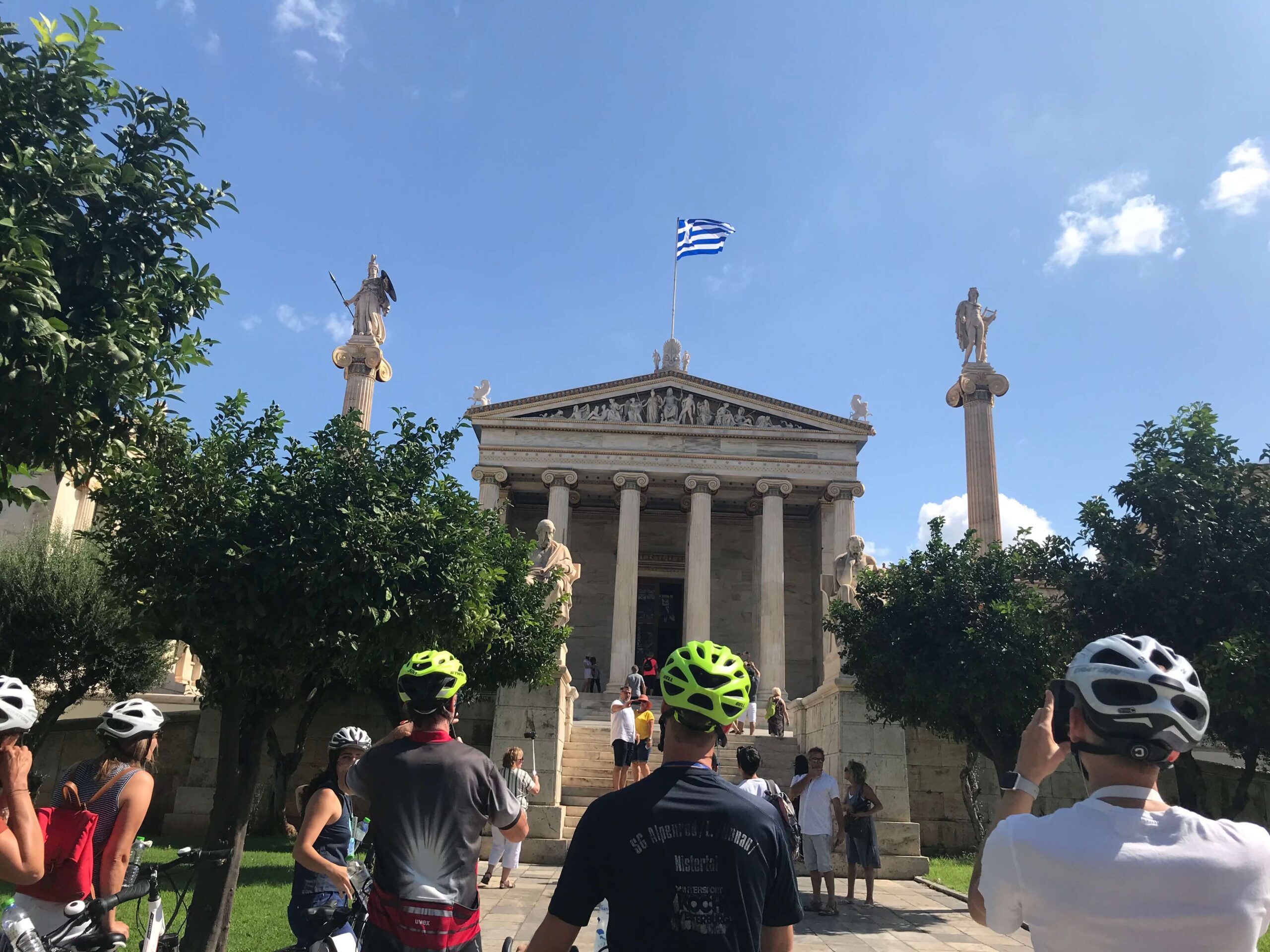
Discover how Athens’ neoclassical architecture tells the story of Greece’s national rebirth. Uncover the city’s iconic landmarks and their connection to the country’s classical heritage.

Neoclassical architecture, which flourished in Greece following its independence from the Ottoman Empire in 1821, marked a profound period of national renewal and identity formation. After nearly four centuries of Ottoman rule, the newly liberated nation sought to reconnect with its classical heritage—an era celebrated through best places to see in Athens that represent the pinnacle of Greek civilisation.
Neoclassicism was the perfect vehicle to express this revival, as it evoked the grandeur of antiquity while celebrating the philosophical and artistic achievements of Greece’s ancestors. At the same time, it symbolised progress, independence, and a visionary outlook for a modern Greek state.
This architectural movement was not only a reflection of Greece’s aspirations but was also shaped by broader European trends. The 19th century saw neoclassicism dominate across Europe, embodying Enlightenment ideals of reason, order, and symmetry – principles inspired by classical antiquity.
The rise of this style coincided with Greece’s fresh start, creating a unique synergy. Prominent European architects, such as Theophil Hansen and Ernst Ziller, invited by Greece’s early ruler King Otto, brought their neoclassical expertise and adapted it to Greece’s unique historical and cultural context.
Athens is a living showcase of this cultural and architectural fusion. Its streets are dotted with neoclassical masterpieces, each standing as a testament to the country’s historical and cultural revival. In this article, we’ll explore five iconic landmarks that reflect this extraordinary architectural period. Let’s take a closer look at these symbols of Athens’ vibrant past and present:
The Athens Academy Hall is a magnificent example of neoclassical architecture and a powerful symbol of Greece’s intellectual and cultural rebirth. Completed in 1885, it was constructed well before the Academy itself was formally established in 1926. The project was funded by Simon Sina, a patron of the arts, with initial work by Theophil Hansen and later completion by Ernst Ziller after Sina’s sudden death.
Part of the iconic Athenian Trilogy, along with the National Library and University of Athens, the Academy Hall draws inspiration from the grandeur of the Acropolis. Its roof features statues of Athena and Apollo, while the figures of Socrates and Plato guard the entrance, paying tribute to Greece’s philosophical legacy.
This architectural gem continues to serve as the heart of Greek intellectual life, promoting science, literature, and the arts, all while embodying the ideals of enlightenment. Today, the Hall remains a proud symbol of Greece’s commitment to knowledge and intellectual progress. Lastly, as a result of the Academy being primarily a research institution and not a public museum to get up-to-date information for any current visitor policies or public events, we recommend checking their official website or contacting them directly. There is a virtual tour, of the interior, on their website tour too. Even though access inside is not easily possible, in our private Tour Old and New Athens E-bike tour with Food Tasting, the Hall is admirable from the outside.
The National Library of Greece, an essential part of the Athenian Trilogy, stands as a monumental testament to the nation’s intellectual heritage. Built between 1887 and 1891 through a generous donation from the Vallianos brothers, the Library was designed by Theophil Hansen and is a true masterpiece of neoclassical design.
Its imposing Doric façade draws direct inspiration from ancient temples, tying Greece’s classical past to its modern aspirations. The Library’s grand entrance, flanked by marble staircases, beckons visitors into a world of knowledge and enlightenment.
More than just an architectural marvel, it houses thousands of manuscripts, rare books, and archives, preserving the country’s literary and historical treasures. The Library is not only a beacon of intellectual pursuit but also represents Greece’s journey from oppression to independence.
Today, it stands as an enduring symbol of Greece’s commitment to both its past and its future. It continues, as such, to serve as the national repository of Greece’s written cultural heritage with its primary operations transferred to its new location, which opened in 2017, in the Stavros Niarchos Foundation Cultural Center (SNFCC) in Kallithea. In our private Tour Old and New Athens E-bike tour with Food Tasting, the Library is part of the landmarks we come across when cycling through Athens.
Zappeion Hall, a monumental structure of neoclassical design, stands proudly as one of Athens’ most iconic landmarks. Designed by Theophil Hansen, construction began in 1874 with funding from philanthropist Evangelos Zappas, a key figure in the revival of the Olympic Games. Completed in 1888, Zappeion was originally intended as a venue for the first modern Olympic Games in 1896, reflecting Greece’s pride in its ancient heritage and renewed cultural identity.
With its impressive Doric columns and expansive façade, Zappeion combines classical beauty with modern functionality. Over the years, it has hosted numerous important events, from political gatherings to cultural celebrations, solidifying its role as a centre of civic life.
Today, Zappeion Hall remains an enduring symbol of Greece’s dedication to preserving its rich history while embracing its future, serving as both an architectural masterpiece and a vibrant cultural venue. Public entrance is not permitted if there is not a specific event or a reservation, but someone can take a look inside with the aid of their website’s built-in virtual tour. If you are not interested enough in its interior, we ride next to it, in our Tour, the Classical Sites of Athens by E-bike.
The Old Parliament Building is one of Athens’ most significant historical landmarks. Designed by Friedrich von Gärtner and completed in 1842, it served as the seat of the Greek Parliament until 1934. The building’s neoclassical style, featuring elegant Ionic columns, reflects both Greece’s classical heritage and its aspirations for democratic governance. Inside, it hosted the debates and decisions that shaped the future of the nation.
Since 2000, the building has been home to the Museum of the Greek Revolution, which commemorates Greece’s struggle for independence in 1821. Through immersive exhibits, the museum brings the heroic stories of the revolutionaries to life, making the building a vibrant cultural hub.
Today, the Old Parliament Building stands as a powerful reminder of Greece’s commitment to freedom and democracy, offering visitors a glimpse into the nation’s revolutionary past and its ongoing journey toward liberty. The museum, inside of it, is open Tuesday to Friday from 9:00 AM to 4:00 PM, and on Saturday and Sunday from 10:00 AM to 4:00 PM, while it remains closed on Mondays. If Athens, now, is not your only destination and there is no time for museum visits, do not mind, we have got that covered in our private Tour Old and New Athens E-bike tour with Food Tasting
The Iliou Melathron, or Schliemann Mansion, is an exceptional example of 19th-century neoclassical architecture. Designed by Ernst Ziller and completed in 1881, it was once the home of Heinrich Schliemann, the renowned archaeologist who uncovered the ancient city of Troy. The mansion, with its splendid marble façade and lavish interiors, reflects Schliemann’s wealth and his admiration for ancient Greek culture.
Today, the mansion houses the Museum of the History of the Greek Coin, as well as temporary exhibits from the National Archaeological Museum. The Iliou Melathron is not only a tribute to Schliemann’s legacy but also a hub for understanding Greece’s rich numismatic history.
The building blends architectural grandeur with historical significance, offering visitors a unique glimpse into both ancient and modern Greece. The National Library of Greece is open Wednesday to Monday from 8:30 AM to 3:30 PM, and closed on Tuesdays. It is also included in our private Tour Old and New Athens E-bike tour with Food Tasting
Athens is a living museum of neoclassical architecture, where each landmark reflects the country’s journey from its ancient roots to modern independence. The Athens Academy Hall, National Library, Zappeion Hall, Old Parliament Building, and Iliou Melathron (Schliemann Mansion) are not only architectural masterpieces but also cultural icons that offer a deeper understanding of Greece’s intellectual and historical legacy. These stunning buildings, designed by some of Europe’s most renowned architects, are a testament to Greece’s dedication to honoring its classical past while embracing the future. Whether you’re cycling through the city or delving into their rich stories on our private tours, these iconic neoclassical structures are an essential part of any Athens experience.

With a background in philosophy, I enjoy weaving together ideas, history, and daily life during my tours.





